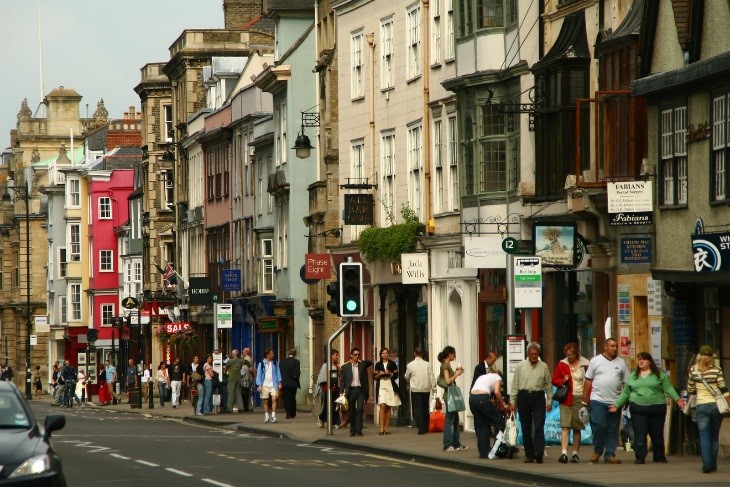AN UNEXPECTED LIFELINE FOR OUR HIGH STREETS?
KEN HOUSTON says it was particularly unfortunate for Glasgow that a financial crisis put Iceland in meltdown before the phenomenon eventually enveloped Europe and North America…
For many years the city had been a favourite weekend destination for Icelandic couples and groups, the link with Reykjavik being one of the few non-stop air services between Glasgow and other European cities prior to the advent of budget airlines.
The Icelanders were famous (and sometimes infamous) for whooping it up on what to them was our incredibly cheap booze. But mostly they came here to spend their money in Glasgow’s shops and department stores.
After Iceland’s descent into financial chaos the weekenders stopped coming and while their numbers were relatively small, they had a tendency to purchase higher-value goods, so their absence did have quite a negative effect on certain retailers.
Much wider, of course, was the effect of the financial crisis here in the UK, because large retail centres like Glasgow – despite discovering a tourist market some time ago – remain dependent on spending from the core population for survival.
One-off major events do have advantages. But as retail figures after the Commonwealth Games showed, they are a small complement to the overall retail spend.
While Glasgow’s hotels, restaurants and bars did a roaring trade during the Games, retail sales were up by only a very small margin.
BUT EVERY CLOUD HAS A SILVER LINING…
For the last six years local authorities have been largely spared the previous pressure from the property development industry for permission to supply ever more retail space – whether in the form of a new shopping mall, an extension to an existing shopping mall, or the addition of a mezzanine floor so that something that began life as a food-based superstore now sells a wide variety of goods that have nothing to do with meat, bread, fish and packets of chocolate biscuits.
That this pressure has let up is not because developers have decided enough is enough. Were it not for the property meltdown it is highly likely that councils would still be badgered with proposals for yet more retail schemes. Some of these might be dressed up as ‘tourist’ or ‘heritage’ projects. But essentially their purpose would be to make money from letting out space to retailers – particularly established High Street brands.
To be fair, saving town centres, or even existing suburban shopping malls, is not the responsibility of property developers. Indeed one could argue that those companies which are publicly quoted have a fiduciary duty to their shareholders to do everything legally possible to add value – and if that means pursuing an opportunity in areas already adequately supplied with retail space, then so be it.
A fresh analysis of the Scottish Retail Consortium's latest survey data has found that Scotland witnessed the third fastest reduction - of 10 nations and regions of the UK - in the number of empty shops over the past six months.
Nevertheless, according to David Lonsdale, consortium director, while this trend is encouraging, action is urgently required on two fronts - business rates and the building standards system.
He said: “I know from speaking to many retailers over recent months that two issues require attention, namely the steep cost of business rates and the building standards system.
“Our members tell us that the building standards system in Scotland is stifling investment. Chief concerns include the sheer length of time needed to secure consents and warrants to open new or expand existing shops, particularly in listed buildings which are common in our town centres, but also for things like putting in seats, toilets and signage.
“Added to a lack of consistency across the country this is holding back much needed further investment in our high streets and town centres."
Alas, business rates will always be with us. But a swifter, and more flexible, approach by local authorities towards planning applications should be achievable at little or no additional cost and would be of particular advantage to town centres.
For more conservative planning officials, preserving the historic frontage of retail premises may not be sufficient and they will go on to insist on the retention of an interior frieze or Doric column even when these may not conducive to doing business.
Town centres have already been disadvantaged by additional laws relating to disability. While no one would argue with efforts to make shopping more accessible for disabled people, the legislation has encouraged a culture of ‘building out’ rather than ‘building up’, which tends to favour less expensive and more spacious edge-of-town sites.
However, recession has provided a period of ‘breathing space’ – in terms of development pressure – which presents an opportunity for a complete re-think on retail strategy, one that goes beyond just business rates and the speed of planning consents and focuses on the wider planning regime.
There were good reasons for abolishing the former regional councils, one being that their size (with the possible exception of Fife) made them the antithesis of ‘local’ government (the largest council, Strathclyde, encompassed half the population of Scotland and about one-third of the country’s land mass).
While the system was balanced with smaller district councils within each region, housing apart, they tended to deal with the crumbs of local government – the big ticket items like education, social work, roads and transport all being regional responsibilities.
DID STRATHCLYDE GET IT RIGHT?
Still, the regions did have one advantage and that was their ability to take a strategic approach to planning. Strathclyde was often accused of being “anti-development” because of its opposition to major edge-of-town shopping centres, to which the council’s planners would reply: “We are not anti-development, just pro-town centre”.
Since the demise of Strathclyde and the other regions, three major, non-central, shopping centres (Braehead, Silverburn and Glasgow Fort) have been developed in and on the periphery of Glasgow.
The popularity of all three suggests a demand from consumers for edge-of-town shopping. Nevertheless, anyone familiar with the boarded-up shop fronts (or surfeit of charity shops) in the once-buoyant centres of the West of Scotland’s principal market towns might have to agree that the Strathclyde planners did, indeed, have a point.
Since the emergence of all-purpose councils, planning decisions have been less consistent. For example in areas of high population density, a council might grant retail planning application for the simple reason that the scheme (and its rates income) will go ahead anyway – in a neighbouring authority.
This seems to support the case for the creation of a number of planning authorities, based broadly on the boundaries of the former regional councils, albeit with what was Strathclyde broken up into two or three constituent parts. These authorities would have powers over the councils in respect of granting major retail consents (what constitutes ‘major’ could be decided at a later stage).
Scot-buzz, rightly, believes that business in Scotland would benefit from less, not more, regulation. However, I believe that the sheer scale of recent retail development makes this sector a special case.
The ‘High Street’ is surely something that cannot be treated as a mere ‘product’. It has been a key component of urban society for at least 2,000 years and only since the advent of mass car-ownership (itself a relatively recent phenomenon) has a threat to its existence ever been perceived.
True, pressure for more edge-of-town shopping may have receded for now but, mark my words, as soon as the property sector recovers, the developers will back with ever more grandiose plans.
Twitter: @PropPRMan




